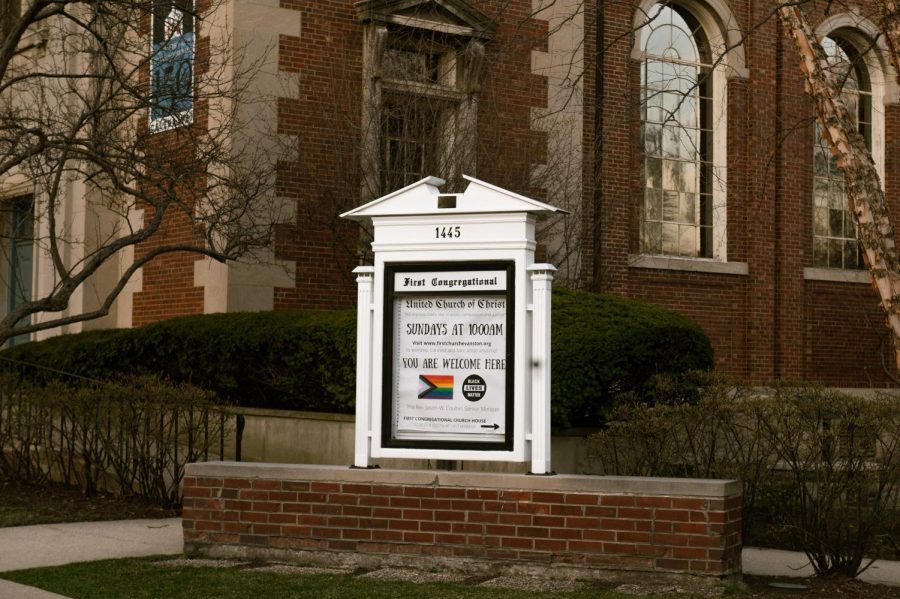Evanston religious spaces offer livestream services, connecting members and generations
Kimberly Espinosa/Daily Senior Staffer
First Congregational Church of Evanston. The church is one of several houses of worship in Evanston offering virtual services.
April 6, 2023
With half her family sick and her trip home for Easter Sunday canceled, a Google search led Skokie resident Carrie Bradean to First Congregational Church of Evanston in 2018. She’s attended the church regularly ever since.
When the COVID-19 pandemic began, First Congregational Church of Evanston kickstarted livestream worship. The virtual options have allowed Bradean to maintain her engagement with the community in times when she could not physically be at church, she said.
Religious spaces across the country started offering virtual services in place of or in addition to in-person ones during the pandemic. According to the Pew Research Center, one in five American adults who attend services monthly participated virtually last Easter.
For some houses of worship in Evanston, the virtual option will remain a permanent fixture, even after the peak of the pandemic.
“It’s opened up that opportunity to connect people still to the congregation that they love,” said Geoff Prass, director of operations at Beth Emet The Free Synagogue.
Prass said two dozen people on average attend Shabbat services in person, out of more than 500 households that belong to the temple. Combining the live-streamed attendance with the in-person figure, services now see participation on par with pre-pandemic attendance, he added.
In recent months, the temple has opted for small, circular seating during services as opposed to rows of seating to accommodate a smaller in-person audience, Prass said.
“Do you embrace that emptiness of the room and not feed off of that energy? Or do you try to say, ‘Okay, we’ve only got 12 people — let’s make this more intimate?’” Prass said.
Some religious spaces, including First Presbyterian Church of Evanston, have invested in cameras and upgraded their software and sound systems to allow for virtual churchgoers, according to Jim Teague, the director of communications at the church.
Livestreams help immunocompromised attendees and appeal to the church’s older congregation demographic, Teague added.
“(Equipment cost) is a drop in the bucket compared to what it provides for our congregation and for visitors,” Teague said. “You cannot have that chunk of your congregation not feel connected.”
Another group, First Congregational Church of Evanston, chose to continue offering online worship to acknowledge that they serve both a virtual and in-person community, the church’s senior minister Jason Coulter said.
Though attendees may occupy different spaces, he said, one body of Jesus Christ connects them during worship, Bible study and other church programming.
“We wanted to meet them where they’re at, with not a second-class status,” Coulter said. “We’re all equal in God’s sight, and we’re all one body of Christ.”
First Congregational Church of Evanston currently streams services through Zoom and offers recordings of worship on-demand. However, the church plans to switch to YouTube Live in an effort to reach more people who may not be congregation members, Coulter said. He estimated that between five and 10 people attend services virtually each week.
For others, transitioning to virtual worship can prove more difficult. One of the founding presidents of Dar-Us-Sunnah Masjid, Mohammed Saiduzzaman, said the mosque does not offer livestreams as some religious rituals cannot be fulfilled virtually.
While the masjid followed COVID-19 policies from the Illinois Department of Public Health policies, COVID-19 was a “circumstance out of religion,” he added.
Bradean noted that virtual church isn’t always the same as the in-person experience. When she attends church virtually, Bradean said she’s more comfortable with the Zoom option because YouTube Live streaming doesn’t offer the same level of closeness.
“It’s just out there on YouTube for forever, and I’ve no idea who’s going to use it or share it in what way,” Bradean said. “There’s no intimacy anymore.”
But, for people who may struggle to attend in-person services, live streams are helpful. Bradean said she cannot always attend morning services or leave the house as easily because of her young children and her health. Though she prefers attending church in person, she said she’s attended by livestream a handful of times.
Her church formed a task force called Becoming the Church in August 2022 dedicated to addressing accessibility in the church.
The task force has discussed live streaming and how to “meet people where they are,” said Anne Trompeter, a member of First Congregational Church of Evanston who serves on the task force.
Virtual religious participation will not replace face-to-face interactions, but Trompeter said it serves as a complement and a way to enrich lives for those who are participating online.
“If it’s done right, it can be an aid,” she said.
Email: lexigoldstein2026@u.northwestern.edu
Twitter: @lexipgoldstein
Related Stories:
— First Congregational Church’s new minister looks to incorporate activism into church leadership
— At 100, Northminster Presbyterian Church reflects on the past, prepares for the future
— Students of different cultures, religions share how they spend Christmas



